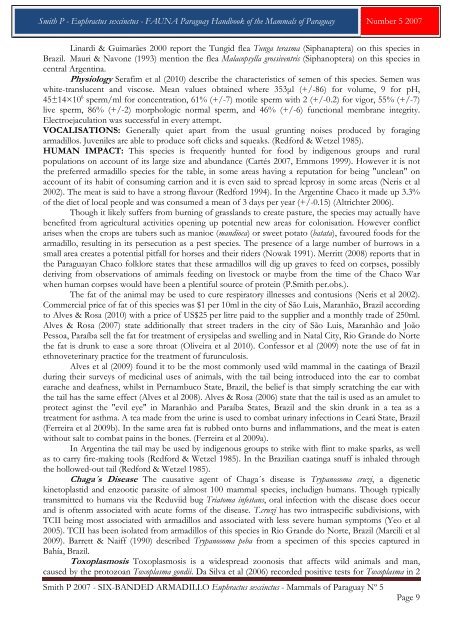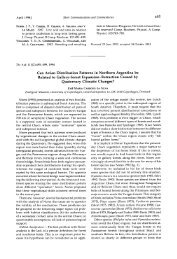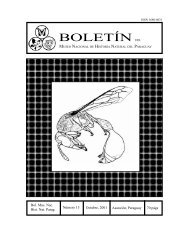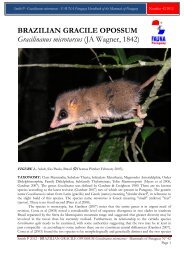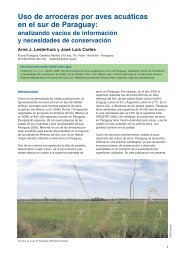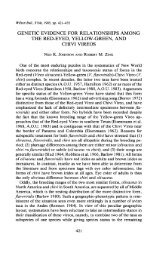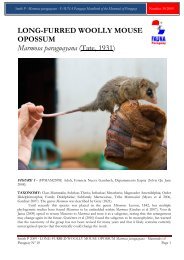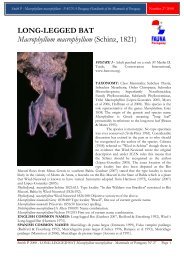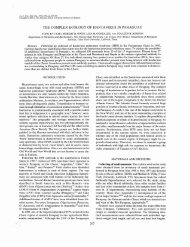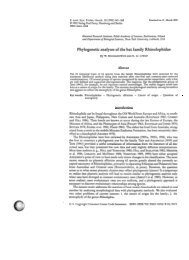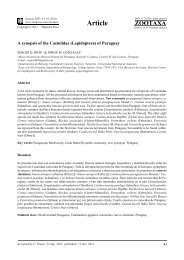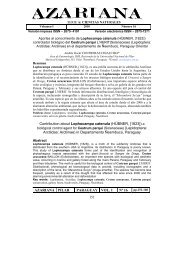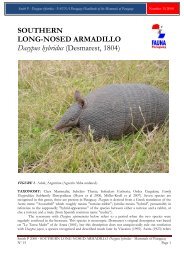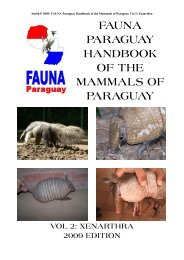Smith P 2007 - FAUNA Paraguay Handbook of the
Smith P 2007 - FAUNA Paraguay Handbook of the
Smith P 2007 - FAUNA Paraguay Handbook of the
You also want an ePaper? Increase the reach of your titles
YUMPU automatically turns print PDFs into web optimized ePapers that Google loves.
<strong>Smith</strong> P - Euphractus sexcinctus - <strong>FAUNA</strong> <strong>Paraguay</strong> <strong>Handbook</strong> <strong>of</strong> <strong>the</strong> Mammals <strong>of</strong> <strong>Paraguay</strong> Number 5 <strong>2007</strong><br />
Linardi & Guimarães 2000 report <strong>the</strong> Tungid flea Tunga terasma (Siphanaptera) on this species in<br />
Brazil. Mauri & Navone (1993) mention <strong>the</strong> flea Malacopsylla grossiventris (Siphanoptera) on this species in<br />
central Argentina.<br />
Physiology Serafim et al (2010) describe <strong>the</strong> characteristics <strong>of</strong> semen <strong>of</strong> this species. Semen was<br />
white-translucent and viscose. Mean values obtained where 353µl (+/-86) for volume, 9 for pH,<br />
45±14×10 6 sperm/ml for concentration, 61% (+/-7) motile sperm with 2 (+/-0.2) for vigor, 55% (+/-7)<br />
live sperm, 86% (+/-2) morphologic normal sperm, and 46% (+/-6) functional membrane integrity.<br />
Electroejaculation was successful in every attempt.<br />
VOCALISATIONS: Generally quiet apart from <strong>the</strong> usual grunting noises produced by foraging<br />
armadillos. Juveniles are able to produce s<strong>of</strong>t clicks and squeaks. (Redford & Wetzel 1985).<br />
HUMAN IMPACT: This species is frequently hunted for food by indigenous groups and rural<br />
populations on account <strong>of</strong> its large size and abundance (Cartés <strong>2007</strong>, Emmons 1999). However it is not<br />
<strong>the</strong> preferred armadillo species for <strong>the</strong> table, in some areas having a reputation for being "unclean" on<br />
account <strong>of</strong> its habit <strong>of</strong> consuming carrion and it is even said to spread leprosy in some areas (Neris et al<br />
2002). The meat is said to have a strong flavour (Redford 1994). In <strong>the</strong> Argentine Chaco it made up 3.3%<br />
<strong>of</strong> <strong>the</strong> diet <strong>of</strong> local people and was consumed a mean <strong>of</strong> 3 days per year (+/-0.15) (Altrichter 2006).<br />
Though it likely suffers from burning <strong>of</strong> grasslands to create pasture, <strong>the</strong> species may actually have<br />
benefited from agricultural activities opening up potential new areas for colonisation. However conflict<br />
arises when <strong>the</strong> crops are tubers such as manioc (mandioca) or sweet potato (batata), favoured foods for <strong>the</strong><br />
armadillo, resulting in its persecution as a pest species. The presence <strong>of</strong> a large number <strong>of</strong> burrows in a<br />
small area creates a potential pitfall for horses and <strong>the</strong>ir riders (Nowak 1991). Merritt (2008) reports that in<br />
<strong>the</strong> <strong>Paraguay</strong>an Chaco folklore states that <strong>the</strong>se armadillos will dig up graves to feed on corpses, possibly<br />
deriving from observations <strong>of</strong> amimals feeding on livestock or maybe from <strong>the</strong> time <strong>of</strong> <strong>the</strong> Chaco War<br />
when human corpses would have been a plentiful source <strong>of</strong> protein (P.<strong>Smith</strong> per.obs.).<br />
The fat <strong>of</strong> <strong>the</strong> animal may be used to cure respiratory illnesses and contusions (Neris et al 2002).<br />
Commercial price <strong>of</strong> fat <strong>of</strong> this species was $1 per 10ml in <strong>the</strong> city <strong>of</strong> São Luis, Maranhão, Brazil according<br />
to Alves & Rosa (2010) with a price <strong>of</strong> US$25 per litre paid to <strong>the</strong> supplier and a monthly trade <strong>of</strong> 250ml.<br />
Alves & Rosa (<strong>2007</strong>) state additionally that street traders in <strong>the</strong> city <strong>of</strong> São Luis, Maranhão and João<br />
Pessoa, Paraíba sell <strong>the</strong> fat for treatment <strong>of</strong> erysipelas and swelling and in Natal City, Rio Grande do Norte<br />
<strong>the</strong> fat is drunk to ease a sore throat (Oliveira et al 2010). Confessor et al (2009) note <strong>the</strong> use <strong>of</strong> fat in<br />
ethnoveterinary practice for <strong>the</strong> treatment <strong>of</strong> furunculosis.<br />
Alves et al (2009) found it to be <strong>the</strong> most commonly used wild mammal in <strong>the</strong> caatinga <strong>of</strong> Brazil<br />
during <strong>the</strong>ir surveys <strong>of</strong> medicinal uses <strong>of</strong> animals, with <strong>the</strong> tail being introduced into <strong>the</strong> ear to combat<br />
earache and deafness, whilst in Pernambuco State, Brazil, <strong>the</strong> belief is that simply scratching <strong>the</strong> ear with<br />
<strong>the</strong> tail has <strong>the</strong> same effect (Alves et al 2008). Alves & Rosa (2006) state that <strong>the</strong> tail is used as an amulet to<br />
protect aginst <strong>the</strong> "evil eye" in Maranhão and Paraíba States, Brazil and <strong>the</strong> skin drunk in a tea as a<br />
treatment for asthma. A tea made from <strong>the</strong> urine is used to combat urinary infections in Ceará State, Brazil<br />
(Ferreira et al 2009b). In <strong>the</strong> same area fat is rubbed onto burns and inflammations, and <strong>the</strong> meat is eaten<br />
without salt to combat pains in <strong>the</strong> bones. (Ferreira et al 2009a).<br />
In Argentina <strong>the</strong> tail may be used by indigenous groups to strike with flint to make sparks, as well<br />
as to carry fire-making tools (Redford & Wetzel 1985). In <strong>the</strong> Brazilian caatinga snuff is inhaled through<br />
<strong>the</strong> hollowed-out tail (Redford & Wetzel 1985).<br />
Chaga´s Disease The causative agent <strong>of</strong> Chaga´s disease is Trypanosoma cruzi, a digenetic<br />
kinetoplastid and enzootic parasite <strong>of</strong> almost 100 mammal species, includign humans. Though typically<br />
transmitted to humans via <strong>the</strong> Reduviid bug Triatoma infestans, oral infection with <strong>the</strong> disease does occur<br />
and is <strong>of</strong>tenm associated with acute forms <strong>of</strong> <strong>the</strong> disease. T.cruzi has two intraspecific subdivisions, with<br />
TCII being most associated with armadillos and associated with less severe human symptoms (Yeo et al<br />
2005). TCII has been isolated from armadillos <strong>of</strong> this species in Rio Grande do Norte, Brazil (Marcili et al<br />
2009). Barrett & Naiff (1990) described Trypanosoma peba from a specimen <strong>of</strong> this species captured in<br />
Bahía, Brazil.<br />
Toxoplasmosis Toxoplasmosis is a widespread zoonosis that affects wild animals and man,<br />
caused by <strong>the</strong> protozoan Toxoplasma gondii. Da Silva et al (2006) recorded positive tests for Toxoplasma in 2<br />
<strong>Smith</strong> P <strong>2007</strong> - SIX-BANDED ARMADILLO Euphractus sexcinctus - Mammals <strong>of</strong> <strong>Paraguay</strong> Nº 5<br />
Page 9


